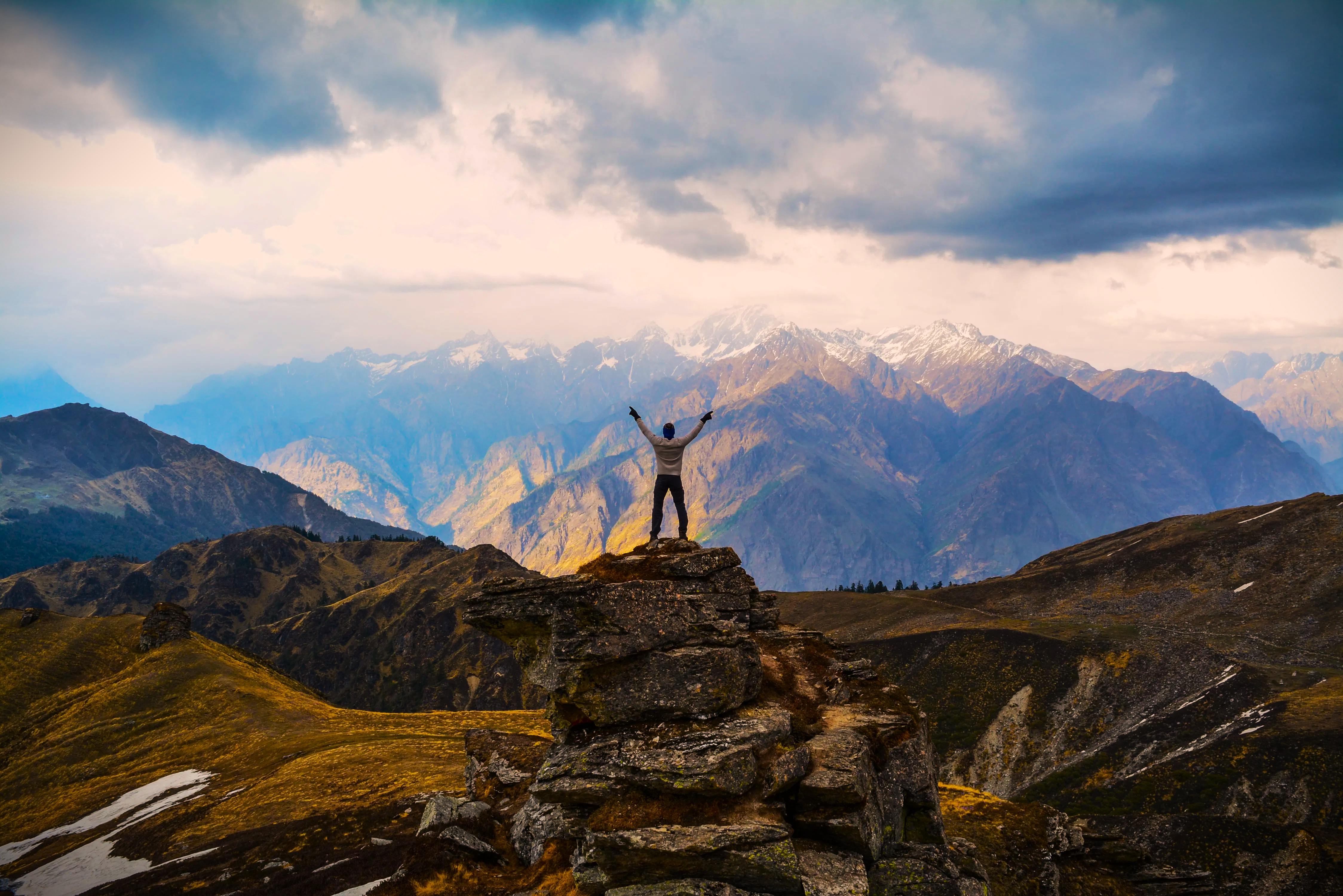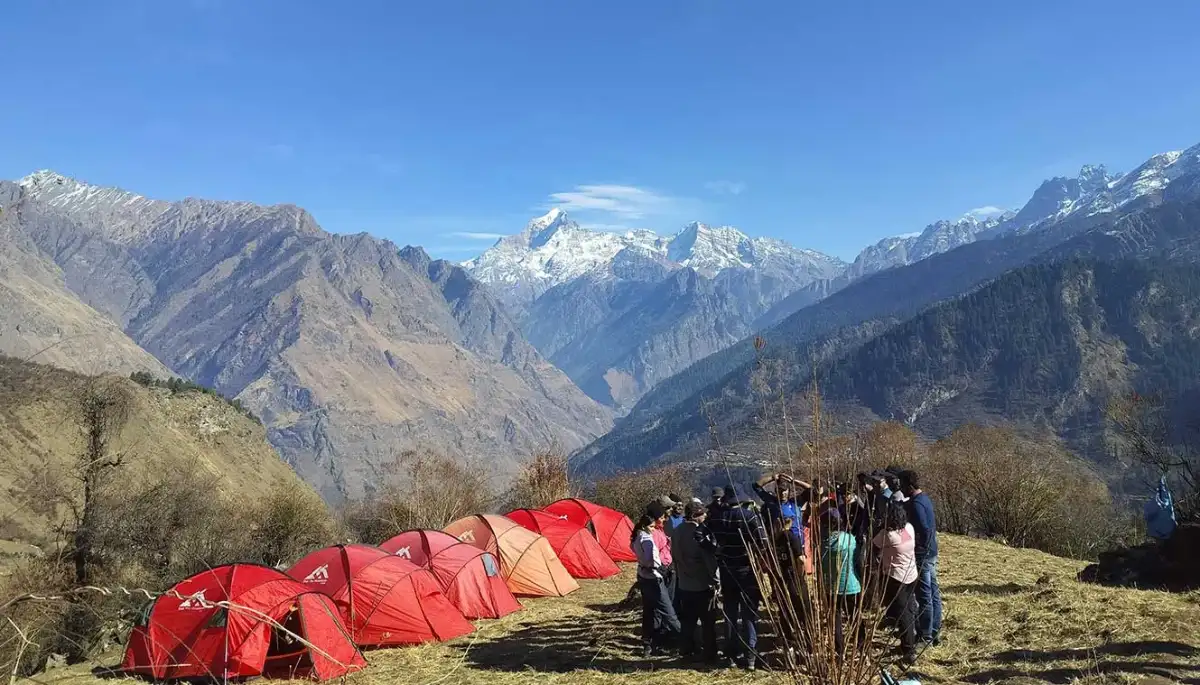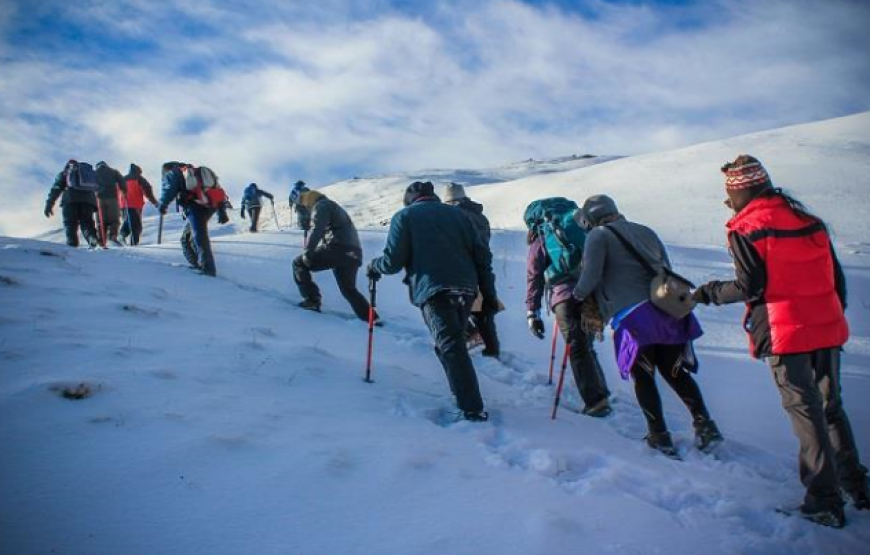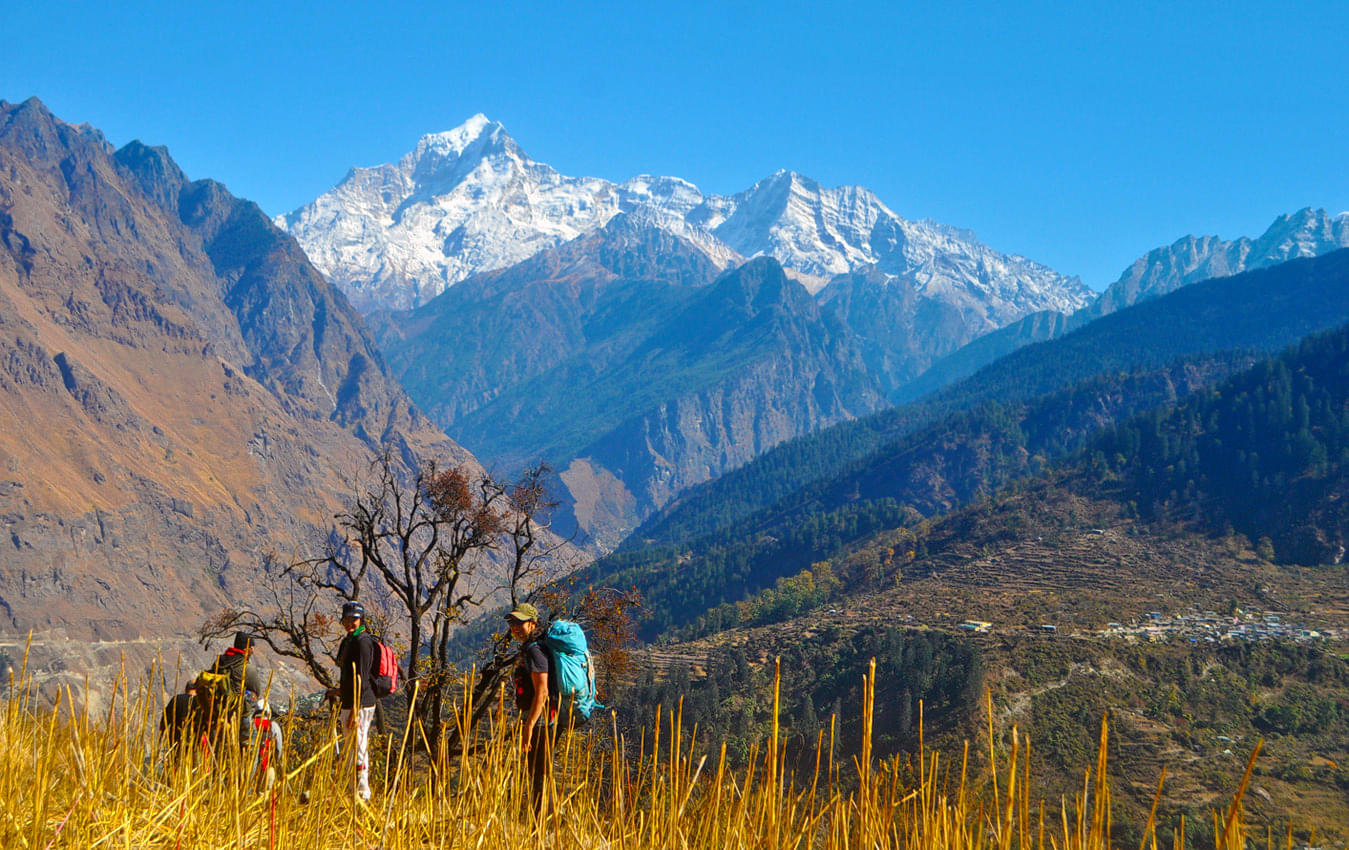Kuari Pass Trek 2025 - Cost, Itinerary & Safety Tips
Published on August 12, 2025
Kuari Pass Trek is a classic Himalayan adventure that promises breathtaking views and a truly rewarding experience. Located in the Chamoli district of Uttarakhand, this trek takes you to an altitude of around 12,516 feet (3,815 meters). It's incredibly popular among trekkers of all levels, from beginners to experienced hikers, because it offers a perfect mix of stunning scenery and a moderate challenge. The trek is famously known as "Lord Curzon's Trail" and offers spectacular panoramic views of some of the most majestic peaks in the Himalayas. From the top of Kuari Pass, you can see towering mountains like Nanda Devi, Dronagiri, Trishul, and Kamet, making it a dream destination for nature lovers and photographers.

Kuari Pass Trek 2025 Itinerary – Day-by-Day Route Plan
DAY 0: Delhi → Joshimath (Overnight Drive)
-
Evening departure from Botanical Garden, Noida
-
Overnight journey via Haridwar, Rishikesh, Devprayag, Rudraprayag
-
Scenic mountain roads from Rishikesh to Joshimath
-
Distance: ~500 km | Travel Time: 12–14 hours
DAY 1: Arrive at Joshimath → Drive to Dhak → Trek to Guling
-
Arrive in Joshimath by morning, freshen up, and have breakfast
-
Drive to Dhak Village – the trek starting point
-
From Dhak, you will be on trekking through steep ridges and sparse forests
-
Trail offers panoramic views of the Hathi-Ghoda peaks
-
Reach Guling Campsite by afternoon
-
Trek Distance: ~5 km | Altitude: ~9,800 ft
-
Stay: Tents at Guling
DAY 2: Guling → Trek to Tali Campsite
-
After breakfast, you will be on trekking through beautiful oak and rhododendron forests
-
Cross scenic sections like Chitrakantha ridge
-
Clear weather reveals first glimpses of Mt. Dronagiri and Nanda Devi
-
Reach Tali Campsite, a serene high-altitude camping spot
-
Trek Distance: ~5–6 km | Altitude: ~11,000 ft
-
Stay: Tents at Tali
DAY 3: Tali → Kauri Pass Summit → Return to Tali
-
Early start today for the most scenic day
-
You will be on trekking to Kauri Pass summit (12,516 ft)
-
Uninterrupted views of Nanda Devi, Dronagiri, Neelkanth, Chaukhamba
-
Spend quality time at the top and descend back to Tali
-
Trek Distance (round trip): ~10 km
-
Stay: Tents at Tali
DAY 4: Tali → Trek to Dhak → Drive to Joshimath
-
Final descent begins after breakfast
-
You will be on trekking back to Dhak via Guling
-
The downhill path retraces earlier forest trails
-
Short drive from Dhak to Joshimath
-
Free evening to explore the local bazaar or relax
-
Stay: Guesthouse/Hotel at Joshimath
DAY 5: Joshimath → Delhi (Drive Back)
-
Early morning departure by vehicle
-
Drive along the Alaknanda River valley
-
Reach Delhi by late evening/night
-
Distance: ~500 km | Travel Time: 12–14 hours

Best Time to Do the Kuari Pass Trek – Seasonal Guide for Trekkers
The Best Time to Do the Kuari Pass Trek depends on what you want to see. This trek is one of the few in the Himalayas that you can do most of the year. The land changes a lot with each season. The best months for trekking are from March to June and September to December.
Spring & Summer (March to June)
This is the most popular time for the Kuari Pass trek, especially for people who are new to trekking.
-
Spring (March to April): You will see a mix of snow and new green plants. The snow starts to melt, and the meadows get green. The red and pink flowers of the rhododendron trees look very nice. The air is fresh, and the weather is good for walking. You might still find some snow higher up.
-
Summer (May to June): The land is fully green. There is no snow on the walking paths, which makes the walk easier. The forests are full of life, and the meadows are covered in green grass. The weather is warm and nice, and the views are usually clear.
Autumn (September to November)
Many trekkers think autumn is the very best time to do the Kuari Pass Trek because of the clear air and amazing mountain views.
-
The Views: After the monsoon rains, the sky is very clear. This means you can see the big mountains like Nanda Devi, Dronagiri, and Trishul without any clouds in the way. The golden color of the grass and the clear mountains make for great photos.
-
The Weather: The weather is cool and steady, with almost no rain. This is a great time to walk without getting too cold or wet.
Winter (December to February) - The Kuari Pass Winter Trek
If you want to see snow and like a tough challenge, a Kuari Pass winter trek is a good choice.
-
The Scenery: Everything is covered in a thick layer of snow. The forests look like a magical white land. Walking on the shining snow is a special experience.
-
The Challenge: Walking in winter is harder and you need special shoes and gear. The weather gets very cold, especially at night, and the days are shorter.
-
Main Difference: A spring trek is about seeing flowers and green land. A winter trek is all about snow, a fun challenge, and the quiet beauty of a cold, white land.

Kuari Pass Trek Packages: Pricing by Comfort Level
The cost of your Kuari Pass trek package can be easily broken down into different tiers, with the price increasing as the level of comfort and privacy goes up.
-
Budget Package (Quad Sharing): This is the most wallet-friendly option, perfect for trekkers who are traveling on a tight budget or in a larger group. By sharing a tent with three other people, you can experience the full trek for a price of ₹12,500 per person.
-
Mid-Range Package (Triple Sharing): Offering a good balance of cost and comfort, the mid-range package is a popular choice for many. You will be sharing your tent with just two other people, giving you a bit more space and privacy after a long day of hiking. This package costs ₹13,500 per person.
-
Premium Package (Double Sharing): This is the top-tier option, providing the most privacy and comfort. Ideal for couples or two friends traveling together, this package allows you to share a tent with only one other person. The price for this premium experience is ₹15,500 per person.
What's Included in a Standard Package
A typical Kuari Pass trek package is a complete solution for the trek itself. Here’s what you can expect to be included:
-
All Meals: All meals from the first day's dinner to the last day's breakfast are usually covered. The food is simple, healthy, and vegetarian, designed to keep you energized.
-
Trek Fees & Permits: All required forest permits, camping charges, and entry fees are included and handled by the tour operator.
-
Equipment: You will be provided with tents (usually on a triple or double-sharing basis), sleeping bags, mattresses, and sometimes even a dining tent and toilet tents.
-
Expert Team: A certified trek leader, a local guide, a cook, and support staff like porters and helpers are all part of the package.
Hidden Costs to Watch Out For
While packages are comprehensive, there are a few extra costs that you should be aware of:
-
Transportation: The biggest hidden cost is often transportation to and from the base village. Make sure to check if the package starts from a major city (like Delhi or Rishikesh) or the base village.
-
Backpack Offloading: If you don't want to carry your bag, you'll need to pay an extra fee to have a porter or mule carry it for you. This cost is usually around ₹300-₹500 per day.
-
Personal Expenses: Costs for personal things like snacks, bottled water, phone charging, or any souvenirs are not included.
-
Medical Insurance: Most tour packages do not include travel or medical insurance. It is highly recommended to get your own.
-
Gear Rentals: While basic equipment is provided, things like trekking poles, jackets, or trekking shoes might be available on rent at an extra cost.
Difficulty Level & Fitness Requirements – How to Prepare Yourself
The Kuari Pass trek is a moderate-level adventure, making it a great option for a wide range of trekkers. To have a safe and enjoyable trip, it's important to understand the challenges and prepare yourself properly. The total Kuari Pass trek Distance is around 28-33 km, spread out over several days, which is why a good fitness level is so important.
Difficulty Level and Trekking Details
-
Difficulty: The trek is rated as moderate. This means it has some challenging parts, including long walking hours and a bit of a steep climb to the pass, but it is manageable for most people with a basic level of fitness. The Kuari pass tour package is structured with a gradual ascent to help you acclimatize.
-
Altitude: The trek goes up to an altitude of around 12,516 feet (3,815 meters). This is high enough for altitude sickness to be a concern, which is why proper acclimatization is very important. The itinerary is designed with this in mind, with gradual ascents to help your body adjust.
-
Trek Duration Per Day: You will typically walk for 5 to 7 hours each day, covering a distance of about 6-12 kilometers. The walking is a mix of uphill and downhill on varied terrain, including forest trails, meadows, and rocky paths.
Who Can Join and Fitness Tips
-
Who Can Join: Anyone with a good level of physical fitness can join this trek. It is suitable for beginners, but they should prepare well. People with serious health issues or breathing problems should consult a doctor before planning this trip. The Kuari Pass trek best time for beginners is often during spring or autumn when the weather is more stable.
-
Start Early: Begin your fitness training at least 4-6 weeks before your trek.
-
Cardio is Key: Focus on exercises that improve your stamina and heart health. Walking, jogging, cycling, or swimming for 30-45 minutes, 3-4 times a week, is a great start.
-
Strengthen Your Legs: Practice walking up and down stairs or hills to prepare your legs for the trek's inclines. Exercises like squats and lunges will also help strengthen your leg muscles.
-
Practice with a Backpack: A week or two before the trek, start walking with a backpack that is similar in weight to the one you will be carrying. This will help you get used to the feel and prepare your shoulders and back.

How to Reach Kuari Pass Trek Starting Point – Travel Options & Routes
The starting point for the Kuari Pass trek is the small town of Joshimath in Uttarakhand. From here, a short drive takes you to the actual trailheads, such as Dhak village. Reaching Joshimath requires a significant road journey through the mountains, which is often a scenic part of the adventure.
Nearest Railway Stations and Airports
-
Nearest Airport: The closest airport is Jolly Grant Airport (DED) in Dehradun. From the airport, Joshimath is about 270 km away, and the drive takes around 9-10 hours.
-
Nearest Railway Station: The nearest major railway station is Rishikesh (RKSH), which is about 250 km from Joshimath. Haridwar is another major railway station nearby. From either of these stations, you will have to take a bus or a taxi to continue your journey by road.
Best Way to Reach Joshimath
-
From Delhi: The journey from Delhi to Joshimath is about 475 km and can take 12 to 14 hours by road. Many trekkers opt for a comfortable overnight bus journey from Delhi to Rishikesh or Haridwar. From there, they take a shared taxi or another bus to Joshimath. You can also hire a private taxi directly from Delhi for a more comfortable but more expensive trip.
-
From Dehradun: The drive from Dehradun to Joshimath is approximately 290 km and takes about 9-10 hours. You can either hire a private taxi or take a shared taxi from the main railway station or bus stand. There are also state-run and private buses that run on this route, which is a more budget-friendly option. It's best to start your journey early in the morning to reach Joshimath by the evening.
Top Attractions & Views on Kuari Pass Trek – Peaks, Meadows & Forest Trails
The Kuari Pass trek is a journey through some of the most beautiful and diverse landscapes in the Garhwal Himalayas. It's not just about reaching the pass; it's about the stunning views and special places you see along the way.
-
Auli Meadows: Your journey often starts near Auli, which is famous for its wide, grassy meadows and ski slopes. From here, you get your first grand views of the snow-covered peaks that you will be trekking towards.
-
Gorson Bugyal: As you trek higher, you will reach Gorson Bugyal, a huge alpine meadow. It offers amazing 360-degree views of the surrounding Himalayan mountains, making it a perfect spot to take a break and enjoy the scenery.
-
Kuari Pass Summit: This is the highest point of your trek and the main goal. From the summit, you get a majestic and wide-open view of some of the most famous peaks in the region, including the majestic Nanda Devi, the Hathi-Ghoda Peaks, and the Dronagiri mountain.
-
Chitrakantha Forest: A beautiful part of the trek is walking through the Chitrakantha Forest. The trail goes through dense oak and rhododendron trees. In spring, the rhododendron flowers add a beautiful burst of color to the path.
-
Tali Lake: Tucked away in a peaceful area, Tali Lake is a serene high-altitude lake. It is a quiet spot, perfect for a short rest and a moment of peace before continuing your trek.
-
Dhak Village: This is a traditional Garhwali village that often serves as the starting point for the trek. Walking through the village gives you a glimpse into the simple and hard-working life of the local people in the mountains.
-
Joshimath Town: This town is the gateway to your adventure. It's a busy place with a lot of history and a starting point for many important treks and religious pilgrimages in the Himalayas.
-
Views of Nanda Devi Sanctuary: The trek also gives you a rare look into the inner part of the Garhwal Himalayas. From certain points, you get to see a special view of the Nanda Devi Sanctuary, a place that is otherwise very hard to get to.
-
Sunrise and Sunset: The views from the campsites are just as amazing. Waking up to see the sunrise on the snowy peaks, with the mountains turning a golden color, or watching the sunset paint the sky with beautiful colors is a photographer's dream.
-
Wildlife and Birdlife: As you walk, keep an eye out for local wildlife and birds. You might be lucky enough to see a Himalayan Monal, which is a beautiful bird, or other animals like musk deer. The trek is also a great place to see many different kinds of plants that grow only at high altitudes.

Kuari Pass Trek 2025 – Top FAQs
1. When is the best time to do the Kuari Pass Trek?
The best season is from March to June and September to November to avoid heavy snowfall and enjoy clear skies.
2. How difficult is the Kuari Pass Trek?
Rated easy to moderate, it’s suitable for beginners and intermediate trekkers with a good fitness level.
3. What is the duration and distance of the Kuari Pass Trek?
Typically, the trek spans 6 days and covers approximately 34 kilometers.
4. What permits are required for Kuari Pass Trek?
A forest entry permit is mandatory and is usually arranged by trekking operators.
5. What kind of accommodation is available?
Tented campsites with basic amenities are common; some packages offer stays in local guesthouses before or after the trek.
6. How can I reach the starting point of Kuari Pass Trek?
Most trekkers start from Joshimath or Lata village, accessible by road from Dehradun or Rishikesh.
7. What are the major attractions on the Kuari Pass Trek?
Highlights include panoramic views of Nanda Devi, Dronagiri, Kamet peaks, oak and rhododendron forests, and alpine meadows (bugyals).
8. Is the trek safe for families and children?
Yes, with proper acclimatization and basic fitness, families and children over 10 years can enjoy the trek.
9. What are the common health risks and safety tips?
Altitude sickness is the main concern; stay hydrated, acclimatize properly, and carry essential medication.
10. What should I pack for the Kuari Pass Trek?
Warm clothing, sturdy trekking shoes, rain gear, sun protection, first-aid kit, and trekking poles are recommended.


.jpg)
